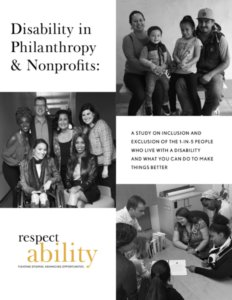Organizations are at their best when they welcome, respect and include people of all backgrounds – and this includes people with disabilities. Fully 1-in-5 people have a learning, mental health, physical, sensory or other disability. People can be born with a disability, or acquire one due to an accident, aging, gun violence or in military service to our nation. People with disabilities want to be included in philanthropy, nonprofits and in solving problems in our communities, just like anyone else.
Disability Belongs™ is philanthropy’s partner to enable funders to have the maximum impact they desire, whether that is in education, training, employment, criminal justice, health, the arts access or other key issues. We encourage you to learn more by reading the resources below. Whenever you need free help and/or partners, reach out to us. We are here for you! Email our Senior Director, Inclusive Philanthropy and Partnerships, Franklin Anderson at FranklinA@DisabilityBelongs.org today!
Free Resources: Inclusive Philanthropy Toolkit
- How We Can Help in Your Work
- Etiquette: Interacting with People with Disabilities
- Terminology Tips: Using the Appropriate Lexicon
- Common Acronyms
- Disability FAQ
- What is considered a disability?
- What is the Americans with Disabilities Act (ADA)?
- What is ableism?
- What is person-first language? What is identity-first language? Which should I use?
- What does it mean to “reclaim” a word, and why is reclaiming important?
- How does intersectionality play into all of this?
- How many African Americans also have disabilities and what should we know?
- How many Latinx and Hispanics also have disabilities and what should we know?
- How many LGBTQ+ individuals also have disabilities and what should we know?
- What should we know about women with disabilities?
- What are some concrete steps to ensure we are inclusive?
- How can I communicate that I am welcoming of people with disabilities?
- How do I ensure my events are inclusive and accessible?
- What is some sample inclusion language to use for accommodations?
- How do I ensure my space is accessible physically?
- How do I ensure my exterior space is accessible physically?
- What signage do I need to be more accessible?
- How do I ensure my website is fully accessible?
- How do I add captions to my online videos for free?
- How do I ensure my other materials are accessible?
- How can I tell if an animal is really a service animal and not just a pet?
- What do I need to know regarding hiring employees with disabilities?
- How can I be more inclusive in my hiring process?
- What is an example of non-discrimination language to include?
- What tax and other incentives do employers have to hire people with disabilities?
- Learn More About Specific Disabilities:
- Attention Deficit Hyperactivity Disorder (ADHD)/Attention Deficit Disorder (ADD)
- Amputation/Amputee
- Autism/Autism Spectrum Disorder (ASD)
- Blind/Vision Loss
- Cerebral Palsy
- Deaf/Hard of Hearing
- Down syndrome
- Dyslexia and Other Learning Disabilities
- Epilepsy
- Little People/Dwarfism
- Mental Illness: Anxiety, Bipolar Disorder, Depression
- Mobility Impairments Requiring the Use of a Wheelchair
- Obsessive-Compulsive Disorder (OCD)
- Equity and Inclusion Resources
- Disability Belongs™ Fellowship Program
Disability in Philanthropy & Nonprofits: A Study on the Inclusion and Exclusion of the 1-in-5 People Who Live with a Disability and What You Can Do to Make Things Better
Download the PDF, accessible Word document, or PowerPoint summary, or view each section of the study by following the links below:
- Acknowledgements
- 1. Executive Summary
- 2. Survey Results: Current Practices
- 2.1. Bias against people with disabilities prevents full inclusion.
- 2.2. Even when DEI is a priority, disability is not.
- 2.3. Lack of advocacy and limited awareness are also significant barriers.
- 2.4. Efforts and accommodations to include people with disabilities are insufficient.
- 2.5. Convenings and communication exclude people with disabilities.
- 3. Steps Forward From This Survey
- 4. How To Include People with Disabilities
- Appendix A: New York – California Comparison
- Appendix B: The Survey Itself: Total, California and New York Data
- Download the full study as a PDF
- Download the Launch Event PowerPoint
Want to learn more?
To ask a question, contact Franklin Anderson at FranklinA@DisabilityBelongs.org.








